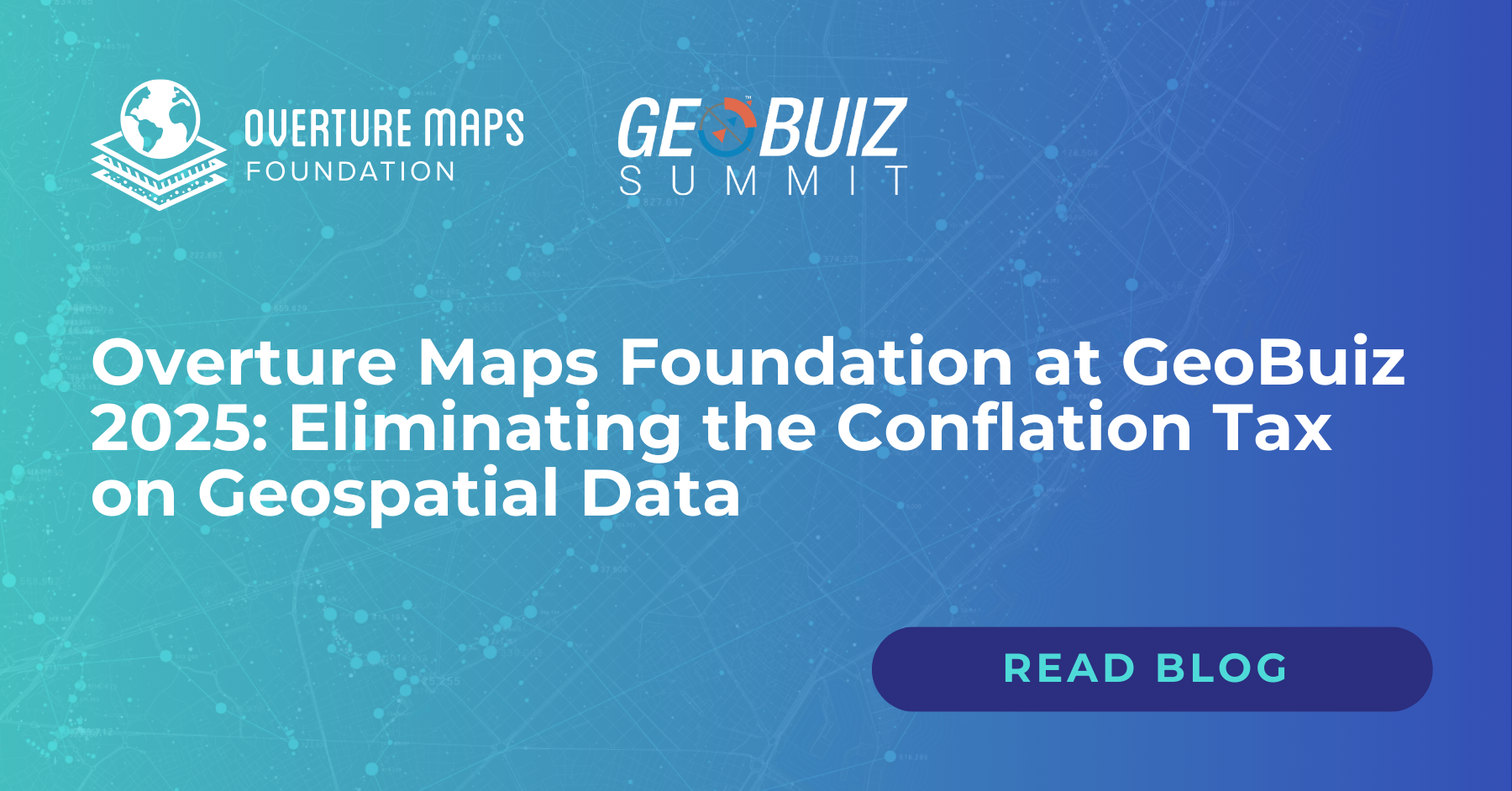 The geospatial industry faces a critical challenge: we’re drowning in data but starving for efficient ways to use it. A recent panel at GeoBuiz 2025 revealed how open map data collaboration might be the solution we need.
The geospatial industry faces a critical challenge: we’re drowning in data but starving for efficient ways to use it. A recent panel at GeoBuiz 2025 revealed how open map data collaboration might be the solution we need.
Watch the full panel discussion on YouTube
The “Tax” on the Geospatial Industry
At a recent GeoBuiz panel titled “Empowering a Map Data Ecosystem for Enterprises and Government Agencies,” industry leaders came together to discuss a problem that’s costing organizations billions: data conflation.
“I spend more money conflating and onboarding the data than I do actually buying the useful data,” admitted Jeff Hightower, VP of Map Data at Microsoft. This sentiment was echoed by other panelists who described data conflation as a “tax on the entire industry.“
For those unfamiliar with the term, conflation is the process of combining multiple datasets with different formats, schemas, and identifiers into a cohesive whole. It’s tedious, expensive, and diverts resources from innovation.
The problem is getting worse, not better. As Leslie Jones, GIO of Alaska, pointed out: “We’re wasting an enormous amount of resources conflating and integrating data on a project level… it’s very expensive.” Both public and private entities face the same fundamental challenge: the explosion of spatial data from diverse sources has created an unsustainable workflow where organizations spend more time preparing data than actually using it for high-value applications.
The Promise of Open Data and GERS
The panel, moderated by Overture’s Executive Director, Marc Prioleau, featured:
- Leslie Jones – GIO, Alaska Geospatial Office, Executive Director at Alaska Geospatial Council
- Jeff Hightower – Vice President, Bing Places at Microsoft
- Drew Breunig – VP of Strategy at Precisely
- Amy Rose – CTO of Overture Maps Foundation
One clear theme emerged: we need easier ways to join data.
Amy Rose highlighted Overture’s approach: “We’re not trying to put together the dataset that everybody will use. We’re trying to put together a very high-quality, open, reliable dataset that is the foundation for interoperability.”
Central to this approach is GERS (Global Entity Reference System), which provides unique identifiers for entities. As Drew Breunig put it, “We kind of have Unix time for locations, which are coordinate systems… but we don’t have [identifiers] for places like this hotel or your house or a river or a road.”
This approach creates what the panel described as a “neutral, foundational layer” that incorporates the best data from public, private, and commercial sources. Instead of each organization maintaining their own base map and conflation systems, they can collaborate on an open data backbone while preserving their proprietary data and competitive advantages.
The promise of GERS is to create a stable, persistent ID system that enables seamless integration of disparate datasets through simple column joins instead of complex conflation processes. As Amy explained, this allows organizations to “track lineage back so that if you’re attaching your data to GERS or to even other data sets via that ID, you can have knowledge that that ID is going to stay stable.
Beyond Column Joins: Expanding the Market
The panelists agreed that standardized, open identifiers would not only reduce costs but expand the entire geospatial market.
“What makes the market bigger? Everything is done to make the market bigger,” explained Drew Breunig. By making it easier for non-specialists to work with geospatial data through simple column joins rather than complex conflation, the addressable market increases dramatically.
This is particularly important as working with spatial data moves beyond traditional GIS specialists. As Drew noted, “Geospatial is still too hard, and when we can make it so all companies have to do is a column join, our addressable market increases by a factor of one hundred.” The panel emphasized that the market for commercial data can expand if the friction of integration is reduced.
From the public sector perspective, Leslie Jones highlighted how this approach helps government agencies: “When you have multiple sources of information, you can more easily validate and then provide more confidence bounds on decisions being made.” She also emphasized the gap between data creators and end users, especially in emergency response situations where decision-makers often lack technical backgrounds but need immediate access to integrated spatial information.
Jeff Hightower from Microsoft reinforced that open data doesn’t mean all data is free and open: “This isn’t what we’re talking about here. We’re talking about having a base layer that allows you to create this market for proprietary data, for richer data.” With less money spent on conflation, companies can invest more in acquiring specialized, high-value data.
Why Now? A Convergence of Factors
When asked why this collaboration is happening now, panelists pointed to a “sea change” in the industry:
- The explosion of data is accelerating, not slowing down
- More general data scientists, not only GIS specialists, are now using geospatial data
- An interoperable layer and modern technologies are making collaboration easier.
- The rise of AI and agent-based workflows demands better data interoperability
Jeff Hightower described how traditional GIS experts are being outnumbered by data scientists who are “rediscovering geospatial from first principles” and building faster tools. This shift represents both a challenge and an opportunity for the industry.
Another important factor is the twin trends identified in the panel brief: the growing acceptance of open data as a valuable resource, and the commitment of major tech companies with substantial resources to collaborate on open map data infrastructure.
As Amy Rose noted, “Nobody wants to be the best at conflation for their business model.” This non-competitive problem is perfect for industry-wide collaboration, representing what the panel described as “a new type of collaboration based around shared interest.”
An audience member thoughtfully summarized the panel’s message by quoting T.S. Eliot: “Where is the wisdom we have lost in knowledge? Where is the knowledge we have lost in information?” They observed that Overture is “making the route from information to wisdom much faster by removing accidental and unnecessary obstructions.” This captures Overture’s core mission: eliminating technical barriers so organizations can focus on innovation rather than conflation.
Looking Ahead: Join the Conversation at GWF 2025
The discussion at GeoBuiz was just the beginning. Overture will be continuing this important conversation at the upcoming Geospatial World Forum 2025 with a panel titled “Managing the explosion of spatial data: How open data can help structure data for government and enterprises.”
GWF 2025 Panel Details:
- Date & Time: April 23, 2025, 14:30 CET
- Panelists: Marc Prioleau (Moderator, Overture), Amy Rose (Overture), Jan Erik Solem (Meta), Dmitry Kuzhanov (Uber), Mike Harrell (TomTom).
This upcoming panel will build on the GeoBuiz discussion and dive deeper into how open data backbones can provide an alternative model for organizing spatial data. It will bring together perspectives from map data users (Uber), map application builders (Meta), data providers (TomTom), and the public sector to explore the potential implications and applications of this collaborative approach.
In addition to this panel, Overture will have a significant presence at GWF 2025, including two other panels and a dedicated workshop focused on GERS implementation. For a complete schedule of Overture activities at GWF 2025, visit here.
Reimagining Public-Private Partnerships
One of the most intriguing aspects of the Overture approach is how it reimagines the relationship between public and private entities in the geospatial ecosystem. Traditionally, Spatial Data Infrastructures (SDIs) have been government-led initiatives that faced challenges due to high costs and technical complexity.
The Overture Maps Foundation represents a new model for public-private partnership where collaboration is driven by shared interests rather than mandates. It acknowledges that both sectors face similar challenges with data integration and can benefit from a common solution.
As Leslie Jones observed from her public sector perspective, this approach allows for maintaining authoritative data while still enabling integration with diverse sources. For private companies, it creates a more sustainable business model by reducing overhead costs and expanding market opportunities.
Get Involved
It’s time, as Amy put it, to “put this particular problem to bed and move on to the real challenges.”
If you’re interested in helping solve this problem together, learn more and participate in these discussions:
- Join us at GWF 2025 by checking the complete schedule of Overture activities
- Consider becoming a member of the Overture Maps Foundation to participate in working groups and task forces and be part of the conversation.
Stay connected: follow us on LinkedIn, X, and Bluesky for the latest updates. Sign up for Overture’s monthly newsletter for exclusive updates on our technical progress and community initiatives.
